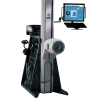
CPT 97110 Documentation and Reimbursement for Therapeutic Exercise
Treatment GuidelinesYou likely use CPT 97110 Therapeutic Exercise in every session. Because it's so commonly used in rehab, many payers highly scrutinize the documentation before approving for reimbursement. Keep reading to learn what you should include in your documentation of CPT 97110.
You likely use CPT 97110 Therapeutic Exercise in every session. Because it’s so commonly used in rehab, many payers highly scrutinize the documentation before approving for reimbursement. Keep reading to learn what you should include in your documentation of CPT 97110.
In many rehab settings, exercise is an integral part of patients’ treatment plans. However, there is often confusion surrounding which CPT codes are most appropriate for various situations. Both rookie and experienced clinicians alike struggle to remember when they should utilize CPT code 97110 (Therapeutic Exercise, or Ther Ex) and how they should justify the use of this code in their documentation. In this article, I will provide an overview of this important CPT code so that you can minimize your reimbursement denials and have more confidence when completing your documentation.
Therapeutic Exercise 101
The AMA considers the use of CPT 97110 appropriate when the clinician prescribes “therapeutic exercises to develop strength, endurance, range of motion, and flexibility”.
This may sound simple enough. For most situations, this definition pretty much encompasses any type of exercise one might imagine. Unfortunately, this AMA definition doesn’t tell the whole story of when it is appropriate and legal to bill for Ther Ex.
Specifically, the clinician must also consider things such as supervision, time, progressive overload/improvement, and specificity of exercise. Also, you should ensure that CPT 97110 is the correct code you should be billing, as compared to therapeutic activity and other, similar codes.
Supervision for CPT 97110 Therapeutic Exercise
CPT 97110 is a direct code. This means that in order for the clinician to legally bill for this modality, they must be working with the patient one-on-one.
This heightened level of supervision ensures that the patient is using correct form and tempo. Also, direct supervision ensures that the patient completes the exercise in such a way that will enable them to see improvement in his condition.
Without direct supervision, patients may be flying through their sets with little attention to detail. As a result, unsupervised exercise is not considered skilled and is generally not reimbursed by payers.
Another element of supervision that is state and payer specific is the question of which clinician is overseeing the exercise. For instance, some states and payers may accept Physical Therapy Assistants and students acting as supervisors for Ther Ex, while others may not.
CPT 97110 is a Timed Code
Some CPT codes are timed codes. This means that the amount of time dedicated to a specific modality will affect how many units the therapist can bill for.
Because Medicare is such a big player in this field, many insurance companies will follow their guidance on timed codes. Specifically, this refers to the eight-minute rule.
The eight-minute rule is a tricky billing procedure. This rule essentially states that a certain timed code must be performed for at least eight minutes, and for a maximum of 22 minutes in order for the clinician to bill for one unit of said code.
Depending on the payer, mixed remainders may also be accepted. Mixed remainders refer to the “leftover” minutes from certain treatments that the clinician can combine together so that a clinician can bill an extra unit. For instance, if a patient was only able to complete 7 minutes of exercise, but completed three minutes of another modality, these times could be combined in order to bill one full unit of a modality.
Improvements Over Time
For CPT 97110 to be accepted on subsequent treatment sessions, the clinician must document patient progress over time. This concept is related to “progressive overload,” which is essentially completing more volume of exercise and / or increasing intensity each visit.
In your documentation, this means specifically noting the reps, sets, and weight of each exercise. These details are very important for CPT 97110, especially when it’s used in multiple sessions or multiple units in one session.
If a client is unable to progress his or her exercise in any way on multiple visits, payers may become suspicious about whether or not continued therapy sessions are warranted. After all, once the patient has moved into a “maintenance stage,” they probably don’t require the skilled eyes of the therapist observing their movements.
Documenting Proof of Progress with BTE Equipment
Documentation of CPT 97110 requires very close attention to detail. If your clinic has BTE equipment like the PrimusRS or Simulator II, the progress reports take all the manual entry and guesswork out of the picture. These reports automatically show changes in volume and work output between sessions. Detailed graphs make it easy to show increased difficulty and improved performance. Plus, clients love seeing their progress over time, keeping them more engaged in your treatment.
Documenting Specific Exercises
When you are helping a patient rehab from an injury, your exercise selections need to be specific to their deficits and requirements. For instance, you would be hard-pressed to justify prescribing squats for an individual recovering from rotator cuff surgery.
There are, of course, exceptions to this rule. Perhaps you are working with a laborer who is initially coming to you for shoulder rehab, but then needs to start work hardening to return to his job. In this case, you could eventually progress to more full-body, functional movements in your treatment plan.
In the end, you must consider the utility of the exercises you are prescribing for this patient and demonstrate how your exercise selection relates to the treatment goals.
Therapeutic Exercise vs. Therapeutic Activity
Therapeutic Activity, or CPT 97530, is a similar procedure code to Therapeutic Exercise. This code is defined by the APTA as “the use of dynamic activities to improve functional performance.”
The key word here is “functional.” Functional activities, such as practicing climbing the stairs, walking, and other things done throughout an average day are not usually considered part of Therapeutic Exercise. Often, Therapeutic Activity movements are more a part of occupational therapy as opposed to physical therapy. However, this is not always the case.
A good question to ask, when deciding between these two codes is, “Is this exercise functional, or more directly tied to a certain parameter of exercise?”
For more details on the differences between Therapeutic Exercise and Therapeutic Activity, check out this article: The 3 Most Common CPTs in Rehab.
Reasons for Denial of CPT 97110
As a clinician, you may rarely deal directly with the billing side of things. You likely complete your treatments, document what you did, and your office manager takes care of the rest. In these cases, it may take a while for you to even become aware of a denied claim.
For this reason, it’s important to make sure that your documentation is iron-clad. The previous section provides a good guide for avoiding denials when billing Therapeutic Exercise. Namely, you should be certain that you document:
- Exactly what exercises the patient is performing and why he is performing them.
- How long the exercise portion of treatment lasted, and how many units were necessary.
- Who supervised the patient’s exercise (i.e. PT, PTA, etc).
- How the patient has improved over time with the given exercises in terms of volume and/or intensity.
In the end, the more detail you can provide for the payers as to the specifics of your patient session, the better.
Additional Resources
Documentation is a skill that takes time to refine, and one that can have a major impact on a clinic’s reimbursement and bottom line. TherapySpark has published a number of helpful resources to help, listed below. If you have a specific question, email is at therapyspark@btetechnologies.com.
- The 3 Most Common CPTs in Rehab (and How To Document Them for Reimbursement)
- Skilled Service Documentation Tips
- Reimbursement for Certified Athletic Trainers
- CMS Revokes Ban of Same-day Evaluation and Therapeutic Procedure
- Understanding the CMS Changes to SNF Reimbursement
Conclusion
CPT 97110 will undoubtedly be a big part of your clinical practice, whether you like it or not. While some payers can be persnickety about the details provided in your documentation, most will be happy to pay as long as you cover the important points discussed in this article.
The important thing for every clinician to keep in mind is that billing should always be legal and an appropriate reflection of the treatments you provided. This billing should coincide with treatments that will lead to a good outcome for the patient by the time they are discharged from your care.
Bennett Richardson, PT, DPT, CSCS
Bennett Richardson, PT, DPT, CSCS is a Physical Therapist and writer. He is the owner of Richardson PT LLC, a mobile, cash-based physical therapy service out of Pittsburgh, PA. Ben is passionate about many health-related topics including weight loss and athletic performance. To get in touch with Ben, visit www.richardsonpt.com
References
- American Physical Therapy Association (APTA). (2018). Guide to Physical Therapist Practice. 3rd ed.
- Centers for Medicare & Medicaid Services (CMS). (2019). Medicare Claims Processing Manual. Chapter 5 – Part B Outpatient Rehabilitation and CORF/OPT Services. Section 20.2 – Components of a Therapy Service. https://www.cms.gov/Regulations-and-Guidance/Guidance/Manuals/Internet-Only-Manuals-IOMs-Items/CMS018912
- Dutton, M. (Ed.). (2012). Dutton’s Orthopaedic Examination, Evaluation, and Intervention. 3rd ed. https://openlibrary.org/books/OL25163122M/Orthopaedic_examination_evaluation_and_intervention
- Hertling, D., & Kessler, R. M. (2006). Management of Common Musculoskeletal Disorders: Physical Therapy Principles and Methods. 4th ed.
- Kisner, C., & Colby, L. A. (2013). Therapeutic Exercise: Foundations and Techniques. 6th ed. ISBN-13: 978-0-8036-2574-7





